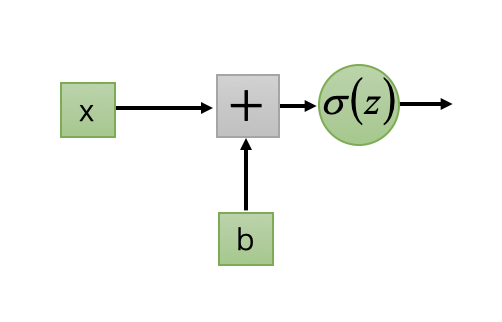感知机是只有一个神经元的单层神经网络。(摘录自课本 Page 17)
多层感知机是20世纪八九十年代常用的一种两层的神经网络。(摘录自课本 Page 19)
首先,感知机和多层感知机都可以接受若干个输入,但感知机只能有一个输出,多层感知机可以有多个输出。
此外,相比感知机而言,多层感知机可以解决输入非线性可分的问题。
确定weight的个数: $$ weights = 33 * 512 +512*10= 22016 $$ 确定bias的个数: $$ biases =1+1=2 $$ 这样,总共可以被训练的参数是22018个。
基于梯度下降法的神经网络反向传播过程首先需要根据应用场景定义合适损失函数(loss function),常用的损失函数有均方差损失函数和交叉熵损失函数。确定了损失函数之后,把网络的实际输出与期盼输出结合损失函数计算loss,如果loss不符合预期,则对loss分别求权重和偏置的偏导数,然后沿梯度下降方向更新权重及偏置参数。
不引入惩罚项的权重更新公式如下: $$ w \gets w-\eta(\triangledown_wL(w;x,y)) $$
仓库地址:https://github.com/LeiWang1999/AICS-Course/blob/master/Code/2.4.activationplot.py
import matplotlib.pyplot as plt
import numpy as np
def sigmoid(x):
return 1.0/(1.0+np.exp(-1.0 * x))
def tanh(x):
return (np.exp(x)-np.exp(-1.0 * x))/(np.exp(x)+np.exp(-1.0 * x))
def ReLU(x):
return np.maximum(0, x)
def PReLU(x, a=-0.01):
return np.maximum(a*x, x)
def ELU(x, a=-0.01):
y = np.zeros_like(x)
for index, each in enumerate(x):
y[index] = each if each>0 else a*(np.exp(each)-1.0)
return y
x=np.linspace(-10,10,256,endpoint=True)#-π to+π的256个值
y_sigmoid = sigmoid(x)
y_tanh = tanh(x)
y_ReLU = ReLU(x)
y_PReLU = PReLU(x)
y_ELU = ELU(x)
plt.grid() # 生成网格
plt.plot(x, y_sigmoid, label='sigmoid')
plt.plot(x, y_tanh, label='tanh')
plt.plot(x, y_ReLU, label='ReLU')
plt.plot(x, y_PReLU, label='PReLU')
plt.plot(x, y_ELU, label='ELU')
plt.legend(['sigmoid','tanh', 'ReLU', 'PReLU', 'ELU'])
plt.show()绘图结果如下:
对输入取区间[-10, 10],a取-0.01:比较取值范围:
| Function | Minimum | Maximum |
|---|---|---|
| sigmoid | 0 | 1 |
| tanh | -1 | 1 |
| ReLU | 0 | 10 |
| PReLU | -0.1 | 10 |
| ELU | 0.00038 | 10 |
- 在损失函数中增加惩罚项,常用的方法有L1正则化和L2正则化,L1正则化可以使训练出来的weight更接近于0,L2正则化可以使全中国weight的绝对值变小。
- 稀疏化,在训练的时候将神经网络中的很多权重或神经元设置成0,也是通过增加一些惩罚项来实现的。
- Bagging集成学习,应对一个问题时训练几个不同的网络,最后取结果的加权,减少神经网络的识别误差
- Dropout会在训练的时候随机删除一些节点,往往会起到意想不到的结果,一般来说我们设置输入节点的采样率为0.8,隐层节点的采样率为0.5。在推理阶段,我们再将对应的节点输出乘以采样率,即训练的时候使用Dropout,但是推理的时候会使用未经裁剪的整个网络。
sigmoid函数如下: $$ sigmoid(x) = \frac{1}{1+e^{-x}} $$ 求sigmoid函数的导数: $$ \frac{\mathrm{d}sigmoid(x)}{x} = \frac{e^{-x}}{(1+e^{-x})^2}=\frac{1}{e^{-x}+e^x+2} $$ 在原点处的值为: $$ \frac{1}{1+1+2}=0.25 $$
当在原点处时,该激活函数的导数取值为1。
题目没有给出,两个隐藏层的神经元个数是多少个,我们可以假设输入矩阵为x,输入层和第一层隐层的权重为w1,第一层隐层和第二层隐层的权重为w2.输出为y,则有: $$ temp=w_1^Tx \\ y = w_2^Ttemp $$ 输出样本的标签由输出y的最大值的下标决定。
当a为[0,1]时,动量项表现为惩罚项,每一次求梯度的时候都会考虑到之前几步更新权重的的动量,并且距离越近影响越大,梯度更新的曲线会越平滑,并且因为考虑到动量,就有可能突破local minimal,找到global minimal。具体的知识可以以momentum为keyword搜索相关资料。
当a为[-1,0]时,动量项表现为奖励项,这样梯度的收敛曲线应该会更陡峭,至于有啥用途想不到。
梯度的计算需要求目标函数关于权重和偏置的偏导数,激活函数不同会导致偏导数不同,进而影响梯度的计算。
设计一个新的激活函数: $$ \delta(z) = e^z $$ 对一个简单的神经元:
则有 $$ y = \delta(wx+b)=e^{wx+b} $$ 选择目标函数为均方误差(mean-square error, MSE): $$ Loss=(\check y - y)^2 = (\check y - e^{w*x+b})^2 $$ 神经元的梯度计算公式: $$ \triangledown_w=\frac{\partial Loss}{\partial w}=-2xe^{wx+b}(\check y - e^{wx+b}) \\ \triangledown_b=\frac{\partial Loss}{\partial b}=2e^{wx+b}(\check y - e^{wx+b}) $$
Github Code Link:https://github.com/LeiWang1999/AICS-Course/tree/master/Code/2.11.fulladder.pytorch
框架:Pytorch
网络结构:简单的MLP、两个隐层layer、各20个node、激活函数使用的是Relu。
class MLP(nn.Module):
def __init__(self, input_dim, hidden_1, hidden_2, output_dim):
super(MLP,self).__init__()
self.layer1 = nn.Sequential(nn.Linear(input_dim, hidden_1), nn.ReLU(True))
self.layer2 = nn.Sequential(nn.Linear(hidden_1, hidden_2), nn.ReLU(True))
self.layer3 = nn.Sequential(nn.Linear(hidden_2, output_dim))
def forward(self,x):
x = self.layer1(x)
x = self.layer2(x)
x = self.layer3(x)
return x数据集构建:
- 使用python实现二进制全加器(
binary_adder.py)、然后遍历输出构建数据集 - 对数据集做了shuffle,再分出训练集和测试集、这样提取的特征更准确
200个epoch可以达到100%的准确率:
[epoch 194] train_loss: 0.920 test_accuracy: 1.000
train loss: 100%[*************************************************->]0.0021
time.perf_counter()-t1
[epoch 195] train_loss: 0.929 test_accuracy: 1.000
train loss: 100%[*************************************************->]0.0021
time.perf_counter()-t1
[epoch 196] train_loss: 0.979 test_accuracy: 1.000
train loss: 100%[*************************************************->]0.0021
time.perf_counter()-t1
[epoch 197] train_loss: 1.004 test_accuracy: 1.000
train loss: 100%[*************************************************->]0.0020
time.perf_counter()-t1
[epoch 198] train_loss: 0.995 test_accuracy: 1.000
train loss: 100%[*************************************************->]0.0020
time.perf_counter()-t1
[epoch 199] train_loss: 0.927 test_accuracy: 1.000
train loss: 100%[*************************************************->]0.0010
time.perf_counter()-t1
[epoch 200] train_loss: 0.979 test_accuracy: 1.000
Finished TrainingGithub Code Link:https://github.com/LeiWang1999/AICS-Course/tree/master/Code/2.12.fulladder.cpp
int main(){
// generate test data
vector<vector<bool>> batch_input;
vector<vector<bool>> batch_output;
vector<vector<bool>> train_input;
vector<vector<bool>> train_output;
vector<vector<bool>> test_input;
vector<vector<bool>> test_output;
data_gen(batch_input, batch_output, true);
data_split(batch_input, batch_output,
train_input,train_output,
test_input, test_output,
0.7
);
// init MLP
int num_layers = 4;
int num_Neurons[] = {9, 20, 20, 5};
int epochs = 200;
MLP mlp(num_layers, num_Neurons);
for(int epoch = 1; epoch <= epochs; epoch++){
cout << "Current Epoch : " << epoch << " Batch Size : " << train_input.size() ;
for (int i = 0; i < train_input.size(); ++i) {
double* output = NULL;
double target[num_Neurons[num_layers - 1]] ;
mlp.input(train_input[i]);
mlp.forward();
output = mlp.get_output();
for (int j = 0; j < num_Neurons[num_layers-1]; ++j) {
target[j] = train_output[i][j];
}
mlp.backward(output, target);
}
int acc = 0;
cout << " training loss : " << mlp.get_loss() << " outputBatchSize : " << test_input.size();
for (int i = 0; i < test_input.size(); ++i) {
double* output = NULL;
mlp.input(test_input[i]);
mlp.forward();
output = mlp.get_output();
// loop neurons
int j;
for (j = 0; j < num_Neurons[num_layers-1]; ++j) {
if ((output[j]<0.5 && test_output[i][j] == 0) || (output[j] >= 0.5 && test_output[i][j] == 1))
continue;
else
break;
}
if(j == num_Neurons[num_layers-1]){
acc++;
}
}
cout << " acc : " << 1.0 * acc / test_input.size() << endl;
}
// data_gen_test();
// mlp_test();
return 0;
}和Pytorch的网络结构基本相同,不同的是激活函数使用的是Sigmoid、而Pytorch里使用的是Relu。
运行结果:
Current Epoch : 938 Batch Size : 358 training loss : 2.74758e-07 outputBatchSize : 154 acc : 0.616883
Current Epoch : 939 Batch Size : 358 training loss : 3.31897e-07 outputBatchSize : 154 acc : 0.668831
Current Epoch : 940 Batch Size : 358 training loss : 4.30856e-07 outputBatchSize : 154 acc : 0.688312
Current Epoch : 941 Batch Size : 358 training loss : 6.82454e-08 outputBatchSize : 154 acc : 0.668831
Current Epoch : 942 Batch Size : 358 training loss : 2.97463e-07 outputBatchSize : 154 acc : 0.714286
Current Epoch : 943 Batch Size : 358 training loss : 1.849e-07 outputBatchSize : 154 acc : 0.714286
Current Epoch : 944 Batch Size : 358 training loss : 1.77274e-07 outputBatchSize : 154 acc : 0.707792
Current Epoch : 945 Batch Size : 358 training loss : 3.79138e-07 outputBatchSize : 154 acc : 0.707792
Current Epoch : 946 Batch Size : 358 training loss : 7.08133e-08 outputBatchSize : 154 acc : 0.701299
